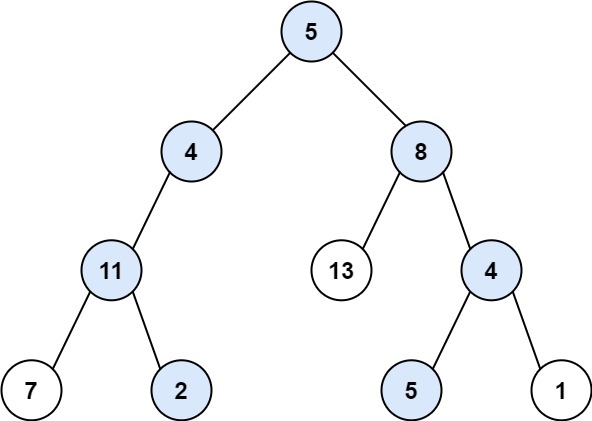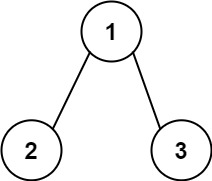Path Sum II
Given the root of a binary tree and an integer targetSum, return all root-to-leaf paths where the sum of the node values in the path equals targetSum. Each path should be returned as a list of the node values, not node references.
A root-to-leaf path is a path starting from the root and ending at any leaf node. A leaf is a node with no children.
Example 1:

Input: root = [5,4,8,11,null,13,4,7,2,null,null,5,1], targetSum = 22
Output: [[5,4,11,2], [5,8,4,5]]
Explanation: There are two paths whose sum equals targetSum:
5 + 4 + 11 + 2 = 22
5 + 8 + 4 + 5 = 22
Example 2:

Input: root = [1,2,3], targetSum = 5
Output: []
Example 3:
Input: root = [1,2], targetSum = 0
Output: []
Constraints:
- The number of nodes in the tree is in the range
[0, 5000]. -1000 <= Node.val <= 1000-1000 <= targetSum <= 1000
Solution
We wish to fill in the template logic:
is_leaf: whennodeis a leaf in the tree, and there is no remaining left.get_edges: the children of the currentnode(node.leftandnode.right).is_valid: an edge (node) is only invalid when it is non-empty (None,null).
In the implementation, we want to check whether node is None first, so that we do not try to get the field of an empty object.
On the current node, we calculate the remaining value after adding the current value.
Then we check whether the node is a leaf so that path is a root-to-leaf path and whether the remaining value left is 0.
If these condition is satisfied, then we have found one solution. If not, we'd have to traverse further until we reach a leaf in the tree (may or may not be a solution).
The below implementation may look different than the template, but essentially one can update and revert path and remaining inside the if-else conditions to gain similarity to the template.
We had also left the check of node is None on the outside to accommodate the use of node.val (and to prevent the root being empty).
Implementation
def pathSum(self, root: Optional[TreeNode], targetSum: int) -> List[List[int]]:
def dfs(node, remaining, path):
if (node is None): return
path.append(node.val) # update path
remaining -= node.val
if node.left is None and node.right is None and remaining == 0: # is_leaf
paths.append(path[:])
else: # edges = [node.left, node.right]
dfs(node.left, remaining, path)
dfs(node.right, remaining, path)
path.pop() # revert path
paths = []
dfs(root, targetSum, [])
return paths

Ready to land your dream job?
Unlock your dream job with a 5-minute evaluator for a personalized learning plan!
Start EvaluatorProblem: Given a list of tasks and a list of requirements, compute a sequence of tasks that can be performed, such that we complete every task once while satisfying all the requirements.
Which of the following method should we use to solve this problem?
Recommended Readings
Coding Interview Patterns Your Personal Dijkstra's Algorithm to Landing Your Dream Job The goal of AlgoMonster is to help you get a job in the shortest amount of time possible in a data driven way We compiled datasets of tech interview problems and broke them down by patterns This way
Recursion If you prefer videos here's a video that explains recursion in a fun and easy way Recursion is one of the most important concepts in computer science Simply speaking recursion is the process of a function calling itself Using a real life analogy imagine a scenario where you invite your friends to lunch https assets algo monster recursion jpg You first call Ben and ask him
Runtime Overview When learning about algorithms and data structures you'll frequently encounter the term time complexity This concept is fundamental in computer science and offers insights into how long an algorithm takes to complete given a certain input size What is Time Complexity Time complexity represents the amount of time
Want a Structured Path to Master System Design Too? Don’t Miss This!
